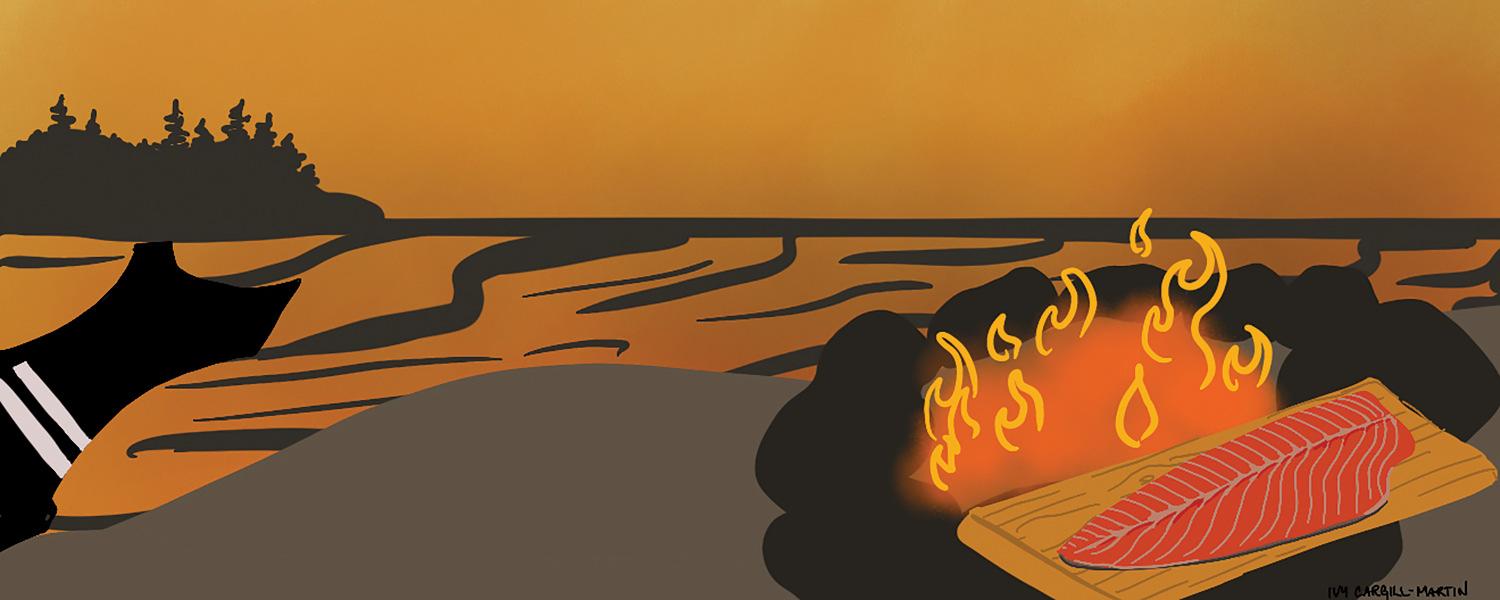
15 minute read
Nations begin plan for invasive crab
Brought over in the bilges of ocean freighters, species has reached 265,000 that were caught in Clayoquot Sound
By Denise Titian Ha-Shilth-Sa Reporter
Advertisement
Clayoquot Sound, BC – The biggest threat to wild salmon you’ve never heard of. That’s what the Coastal Restoration Society calls the invasion of the European Green Crab in Pacifi c coastal waters. “Invasive European Green Crab are being found up and down the West Coast in larger numbers than ever. These crabs outcompete native species and destroy sensitive and ecologically important habitat,” they say. With funding from the British Columbia Salmon Restoration and Innovation Fund, a partnership was formed between the Coastal Restoration Society, BCSRIF, Fisheries and Oceans Canada, Ahousaht, Tla-o-qui-aht and T’Sou-ke First Nations to begin work to tackle the problem. Together, they have launched a project to study industrial trapping as a way to mitigate the impacts of European Green Crab on the West Coast of Canada. European green crabs are a small, invasive species that are voracious predators of clams and juvenile Dungeness crab. They quickly destroy eel grass beds that serve as habitat for young salmon. They have been present on the Atlantic Coast of North America for more than 200 years but have only been on the west coast Vancouver Island for about 20. It is believed that they arrived on the Atlantic coast in the bilge waters of trans-ocean freighters. Crysta Stubbs of Coastal Restoration Society says the European Green Crab showed up in San Francisco, California in 1989. They believe larvae-infested seaweed used to package seafood from the Atlantic coast was improperly disposed of and, over the years, the larvae fl oated on the current north, up to Vancouver Island. It was 1999 when the invasive species was fi rst detected on the island’s west coast. Local seafood harvesters in the Sooke Basin and Clayoquot Sound have been fi nding the crab on beaches and in traps, killing them as they fi nd them. It wasn’t known how bad the infestation was, until the pilot trapping project began in November 2021. According to Stubbs, two teams of workers began trapping the invasive crab last November. One team works in Sooke Basin and the other in Clayoquot Sound with Ahousaht and Tla-o-qui-aht people. She said the teams of three or four people set 40 traps in four Clayoquot Sound sites over fi ve days a week. “The number one goal is removal of the green crab, but we are also collecting data,” said Stubbs. This is the fi rst-ofits-kind attempt to control the green crab through industrial, commercial-scale trapping. Workers, mostly local First Nations, also monitor the health of the eel grass beds as they work. They count the crab as they pull traps and euthanize them by freezing them. The fi rst trap set in Tranquil Inlet estuary in November 2021 yielded 500 green crabs. “And that was supposed to be a bad time for green crab,” said Stubbs. In the fi rst two weeks they trapped nearly 9,000 green crab in the Tranquil Inlet estuary. “Tla-o-qui-aht First Nation has really lush crab grounds, large fans of eelgrass and mudfl ats, a lot of great habitat,” said Saya Masso of Tla-o-qui-aht. “To have an invasive species that comes in that has less marketability, less meat on the animal itself, is just a negative for everyone in the region.” Ahousaht’s Tyee Ha’wilth Hasheukumiss, Richard George, said he had no problem signing off on the project, noting his concern that more than a quarter million crabs have already been trapped in Clayoquot Sound. “They’re everywhere, it’s kind of scary,” said Stubbs. They pulled 10,000 green crabs at the Cypre River estuary in one day, making that their highest count in one day. But Stubbs says that the work that they’re doing has had a positive impact. “The numbers are defi nitely coming down…Cypre went from 10,000 green crab caught in a day to 2,000 in one day, in a recent count,” she noted. “This is something that’s not going to go away, it’s not possible.” The trapping program only has funding to run to spring 2023 but Stubbs hopes federal funding will be extended to continue the work. Ultimately, she hopes that a program like this can grow and, with coordinated eff orts, reduce the green crab population on the Pacifi c coast in both Canada and the US. If not, Stubbs says we can expect to see negative impacts on eelgrass beds, which are important habitat for the already struggling salmon and herring stocks. In addition, the green crab will negatively impact Dungeness crab, clams and other bivalves through predation. The European Green Crab have no economic value. The 265,000 green crabs caught in Clayoquot Sound are being stock piled in freezers. Stubs hopes that they can be composted and used as fertilizer but there are concerns that need to be addressed before that can happen. ` Stubbs says the Coastal Restoration Society is always on the lookout for funding to keep the project going. They hope that with their work and data collected, European Green Crab numbers will be decreased to the point that the ecosystem can function normally. “This project needs to be collaborative and widespread as possible in order for it to be successful,” said Stubbs.
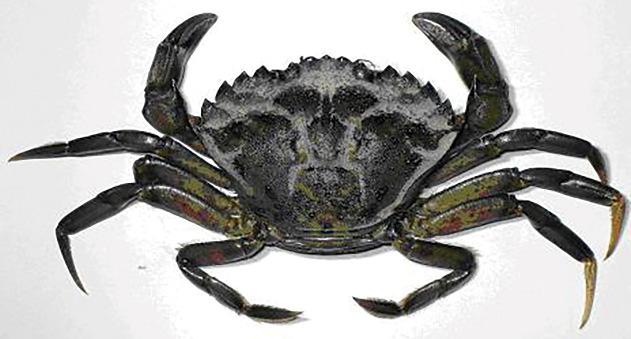

Page 8— Ha-Shilth-Sa—September 22, 2022 Chinook run yields healthy returns in Somass Riv
Area 23 continues to a ract a high number of boats to harvest the largest salmon species, thanks largely to a hatchery by Great Central Lake
By Eric Plummer Ha-Shilth-Sa Reporter
Port Alberni, BC - In mid September Tseshaht and Hupacasath fi shers were casting their nets in the Somass River, taking advantage of the last days of a large chinook salmon run. In recent years Fisheries and Oceans Canada has stressed the growing challenges facing Pacifi c salmon. The department’s 2019 State of the Canadian Pacifi c Salmon report stressed the environmental impacts of a warming climate on the fi sh, which normally thrive in cooler waters. The report stated that chinook are declining throughout their range, while some southern B.C. sockeye populations face imminent extinction. But this year the number of sockeye that returned from their ocean migration to Barkley Sound and the Somass River ended up being double the pre-season forecast, while approximately 135,000 chinook are expected to come back. The area’s chinook fi sheries are heavily reliant on breeding the large salmon in a hatchery by Great Central Lake, which produces 90 per cent of what returns to the Somass watershed. “All in all a decent season,” summarized Dave Rolston, fi sheries manager for the Tseshaht First Nation. “The sockeye runs are doing reasonably well, for the most part, and this year was a good one. And the chinook is pretty steady. So all of those factors combined attract a lot of fi shermen, a lot of commercial fi shermen, a lot of rec fi shermen, so it’s a very dynamic and busy fi shing location.” Area 23, which includes Barkley Sound and the Somass River, is managed throughout the season by weekly round-table meetings, with participation from the local First Nations, DFO as well as representation from the commercial and recreation sectors. On some days commercial openings attracted over 200 vessels on the Alberni Inlet, said Rolston, while 200 to 300 Tseshaht members took to the river to participate in the Somass fi shery, representing as much as one quarter of the First Nation’s population. The Somass fi shery is shared with the Hupacasath First Nation, which had about 55 members on the water exercising their rights this summer. Chinook fi shing, which started in the second week of August this year, brought more community participation than the earlier sockeye migration, said Graham Murrell, fi sheries manager for the Hupacasath First Nation. Murrell doesn’t expect that the two First Nations will reach their total allowable catch limit (TAC), which was set at around 37,700 chinook between Tseshaht and Hupacasath for the season. “They did show up early, you would have thought they would have been slower with not much rain happening,” he said of the chinook migration up the Alberni Inlet and into the Somass River. “We’re ahead of the curve defi nitely, in terms of escapement.” Rolston noted that chinook and coho “came in very quickly”, a dynamic he says could have been attributed to cooler water conditions this year. By late August Vancouver Island entered a Level 3 drought
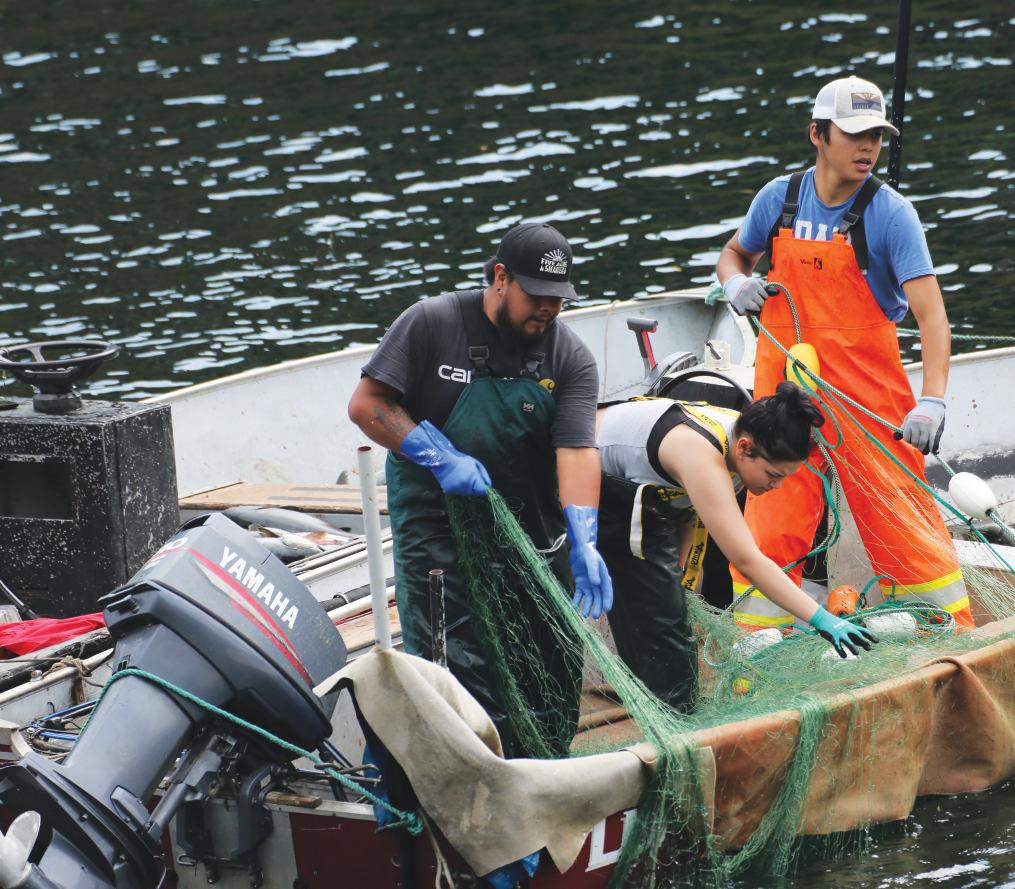
First Nations fi shers pull in a net on the Somass River, after casting a circle set to catch the remains of the chinook run. The First Nations and Hupacasath First Nations, who partake in an economic ventured that usually generates over $1.5 million.
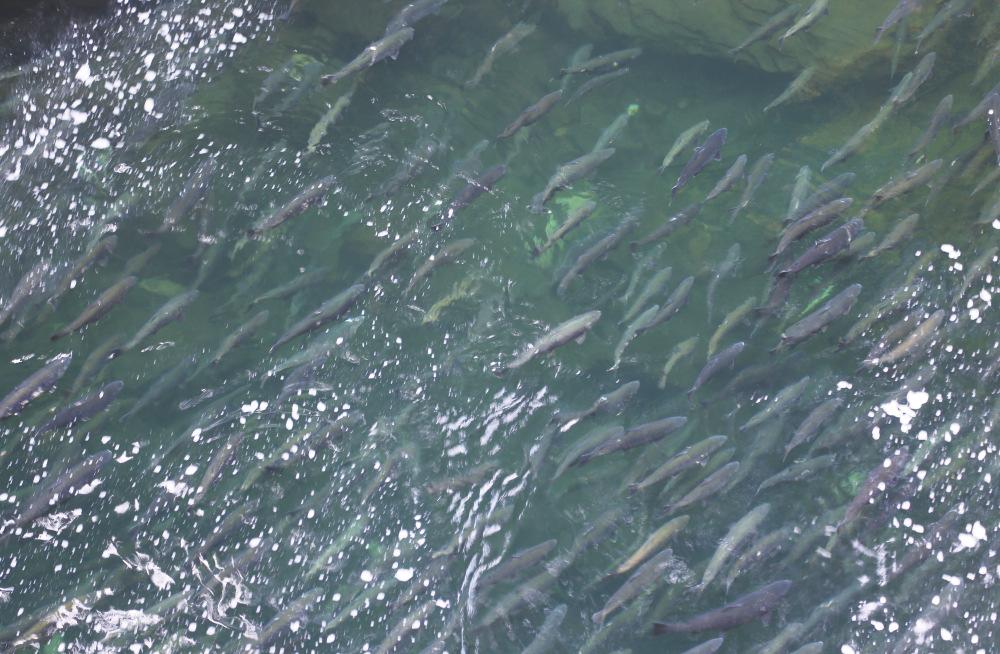
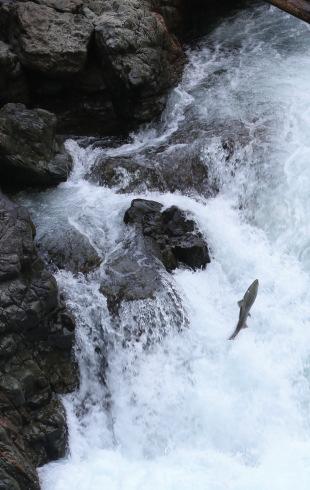
Photos by Eric Plummer shers pull in a net on the Somass River, after casting a circle set to catch the remains of the chinook run. The First Nations fi shery is shared by the Tseshaht
~ Jim Lane, Uu-a-thluk deputy program manager
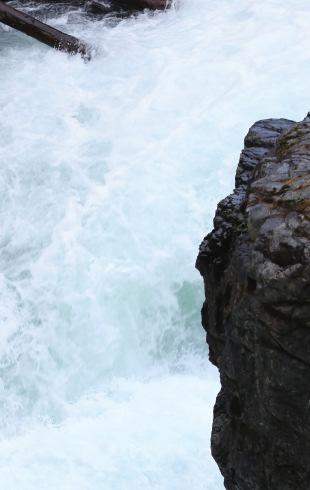
Commercial fi shing vessels fi ll the Alberni Inlet in mid September, in anticipation of an opening for the regulated chinook and coho fi shery. stage, after reaching the severe Level 5 during the same period in 2021. “They didn’t spend a lot of time in the harbour, waiting at the top end of the inlet,” said Rolston of this year’s chinook and coho migration. “That made it challenging to catch our TAC.” A ‘chess game’ of co-management As in most years, the First Nations harvested from the river under an economic opportunity agreement with DFO. Eighty to 90 per cent of catches were sold to two Vancouver Island companies: French Creek Seafood from Parksville and Hub City Fisheries of Nanaimo. Although he didn’t expect the Tseshaht would reach their total allowable catch, Rolston estimates the chinook run generated $1.5 million for the Tseshaht First Nation. “There was opportunity for a number of our members to earn a living,” he said, noting that this is possible from the commercial, recreational and First Nations fi sheries jointly coordinating a management of the area over the course of the fi shing season. According to the most recent Somass fi sheries bulletin issued by DFO, over 69,000 chinook were estimated to be caught, including 23,224 for the Somass First Nations, 1,103 for Maa-nulth treaty nations, 11,224 for the commercial Area B seine fl eet, 15,838 for Area D gillnet boats, 16,983 to be caught by recreational boats and 638 taken by a test vessel. “It’s a chess game in movement all the time around numbers and around openings and closings,” noted Rolston. “You don’t want to fi sh on top of another group,” added Murrell. “You want to make sure that the rec boats have safe passage in and out of the marina during their busy times.” Chinook averaged 13-14 pounds each this year, said Rolston, compared to the typical 18-pound fi sh from last year. “We’ve seen a lot of three-year-olds,” added Murrell of this year’s chinook run. “They’re smaller, 10-12 pounds, sometimes less.” The early-season price was $6 a pound, which lowered to $3 by the end of the chinook season. The market is aff ected when Alaskan chinook become available. “As Alaskan fi sheries come on, particularly Bristol Bay, then the price drops dramatically,” explained Rolston. A hatchery dependent system Ninety per cent of the chinook caught in the Somass River and Alberni Inlet originated from the Robertson Creek Hatchery, a facility by Great Central Lake, where many of the salmon are destined to return to die at the end of their multi-year migration to and from the Pacifi c Ocean. These hatchery-raised chinook have the same genes as their wild-born counterparts, but they have the advantage of being released into rivers and estuaries at a larger size. Naturally born chinook usually enter the calm, nutrient-rich waters of estuaries weighing 0.5 to one gram, while the hatchery salmon are released at 4-8 grams, explained Jim Lane, deputy program manager for Uu-a-thluk. “We don’t really know what happens in the fi rst three or four months of their life,” he said of the species. “We assume a lot of the mortality happens in that time.” “It’s a hatchery system, and that’s what’s keeping it going in the valley,” said Murrell of fi sheries in the Port Alberni area. Fisheries managers are observing that chinook are coming into the Somass smaller than they were a generation ago. Lane has seen hatchery raised salmon return younger that those born in the wild. “The age of fi sh when they return is generally younger than if it was a wild population,” he said. “You see a higher proportion of three-year-olds than you would see in the wild.” But a number of other factors could be aff ecting the size of the fi sh, including ocean conditions that have brought higher temperatures in recent years. Rolston also noted that commercial nets could be bringing in more large salmon, which can be sold at a higher price. “Over the years people cream off the bigger fi sh because the TACs are a piececount, but you get paid by the pound,” he said. “Area D, for example, wouldn’t want to end up with a lot of small fi sh.” Despite the 30 million eggs that fi sheries managers expect will be deposited in the area’s rivers this year, Murrell admits that there is yet to be a “smoking gun” that reveals why more of the chinook born in the wild aren’t surviving to return. “We have to fi gure out why we’re not getting that production before the next steps of what can we do to increase it,” he said. “Why they’re not surviving now, while they did up to the early 90s, we don’t know,” said Lane. “That’s one of the things we’re trying to fi gure out.” Meanwhile the future of the Area 23 fi sheries, and how its salmon will be produced, rests on how much of a dependence will be placed on breeding fi sh in a facility. “Are you going to have a river that’s predominantly going to be for enhancement fi sheries, and the others are going to be more wild? Or are they managed to maintain a high percentage of natural infl uence?” asked Lane. “Those are societal questions.” The chinook fi shing season might be almost over, but the salmon will continue to migrate up the Somass River into the autumn, benefi tting from cooler water when rains begin and the summer heat subsides. As many as 13,000 have been known to pass through the river in one day, said Murrell. “Chinook are powerful swimmers,” noted Rolston. “Once they get adjusted to fresh water, and that doesn’t take long, they can boogie many, many kilometres in the run of a day if they wish to push through.”
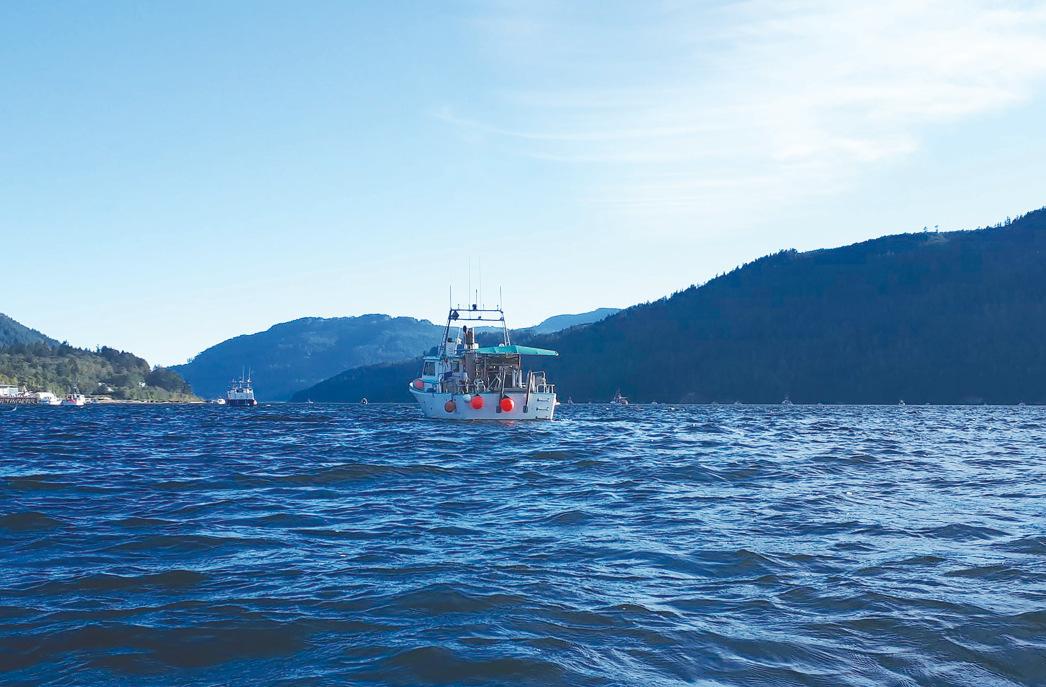
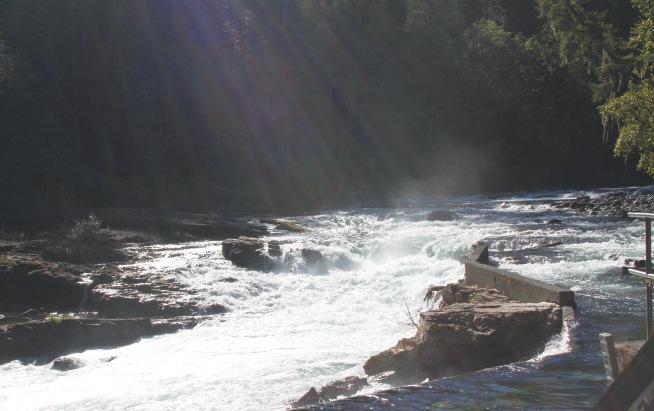
The two chaputs will be used to give children in care more opportunity to participate in cultural activities
By Denise Titian Ha-Shilth-Sa Reporter
Port Alberni, BC – A pair of 36-foot fi breglass canoes purchased by Usma Nuu-chah-nulth Family and Child Services in 2021 have been offi cially named and decorated with Nuu-chah-nulth art, as they are now available to help children in care stay connected with their culture. The canoes were unveiled at a Sept. 8 Usma open house held at their 6th Avenue location. The canoes will be used for summer activities with children in care, so that they can take part in cultural activities like canoe journeys or paddles to their home communities. It is part of Usma eff orts to help children in care stay connected to their culture and their communities. Artist Georgina Haiyupis was commissioned to come up with a design for each canoe based on their names. She put much thought into both the designs and about the safety and well-being of the children that the canoes will carry. Dozens of people were in attendance, including Nuu-chah-nulth Tribal Council President Judith Sayers, as tarps were pulled off of the beautifully painted canoes. Haiyupis told the crowd that her designs were made based on the teachings and values of Nuu-chah-nulth culture. The colors were selected not only for their beauty, but also for their easy-to-spot brightness that will keep the children safe while they are on the water. One canoe is named ʔiiḥ camisukʷin qʷameeʔitq taatna, meaning every child matters. Haiyupis painted an image of a mother bear and her cub, representing the strength of the protector, who has the courage to stand up for what’s right. “They have the ability to keep fi ghting even if they’re wounded,” said Haiyupis. The design also features swallows, a common bird that protectively cares for its young. The salmon and their eggs represent resilience, as the salmon sacrifi ce themselves to lay their eggs, regenerating the next cycle. The second chaputs (canoe) was named ƛuł–ik-yuk, or Sea Serpent. This chaputs features the Thunderbird, represent-
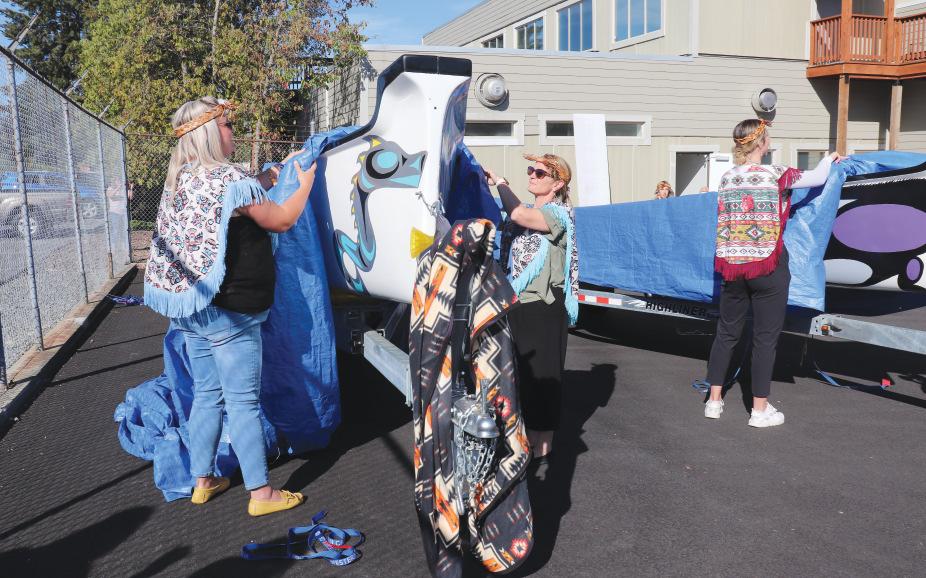
Photos by Denise Titian One canoe is named ʔiiḥ camisukʷin qʷameeʔitq taatna, meaning every child matters. The second chaputs (canoe) was named ƛuł–ik-yuk, or Sea Serpent.
Georgina Haiyupis ing power, protection and strength, said Haiyupis. She also included images of whales and wolves representing everlasting family bonds and the protection of future generations. Haiyupis thanked Usma for sharing this gift of canoes with the children. “Investing in our children is what will restore their identity, their pride and their knowing where they come from – that’s important,” she said.
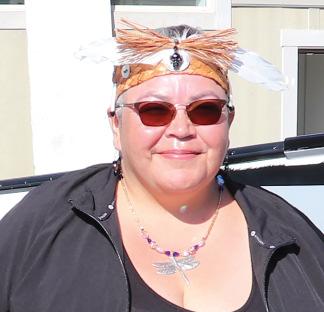
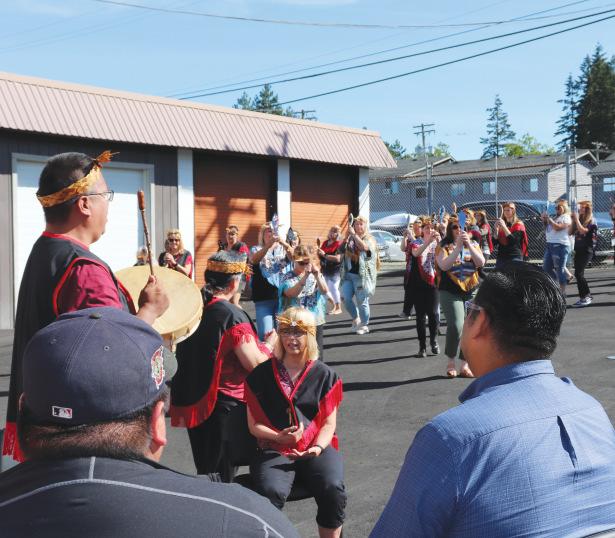
Phrase†of†the†week:†ʔumaḥ saš iiš ʔał ƛapc’as ḥ isit ʔuḥ wałʔaƛquu ḥ umiis
Pronounced ‘Ohh math sis alth clup juss his it ooh walh alth koo alth whoom is’, it means, ‘I get a real hankering for barbecue sockeye salmon, cooked on cedar wood’. Supplied by ciisma.
